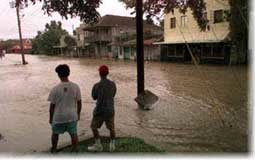|
After the Flood
Flooding can bring more than just water into your home. Germs like E. coli, coli,
Salmonella and Shigella thrive in contaminated water. Therefore, it is extremely important to clean-up the germs that can be found and spread in floodwater. The following tips can help you to clean your home and help protect you and your family from illness.
1. Make sure your water is safe to drink
Check with the local Health Department to determine that your water supply is safe before drinking, cooking or cleaning. Remember to carry bottled drinking water to flood site clean-ups.
2. Protect yourself
Protect yourself during clean-up by wearing protective clothing such as boots, gloves and masks. Clean and disinfect all cuts, scratches and abrasions. Seek medical attention to prevent infection from unprotected exposure to germs.
3. Remove spoilage
Discard any fresh or packaged food products that may have come in contact with floodwater. Wash canned food containers and wipe dry with paper towels or napkins to help remove contaminating microorganisms. Throw out food products if you have any doubt about their safety.
4. Take care of your health
Hygiene risks abound and those with increased susceptibility need to be vigilant. Anyone with special medical conditions and concerns need to be especially careful of the dangerous health risks a flood often creates.
5. Air out affected rooms
It is important to ventilate your home. Open all doors and windows to allow air to circulate and dry out your home. Dehumidify as soon as possible after flooding.
6. Discard items which cannot be rendered mold-free
After the flood, throw away any items that do not dry completely because they can harbor germs and produce mold, which can irritate allergies as well as lead to respiratory or other illnesses.
7. Disinfect all affected areas (see Chemical Information below)
All surface areas in the house, including the walls, staircases and items in contact with floodwater should be washed, disinfected and wiped dry with paper towels to minimize bacterial contamination and reduce the potential for mold growth.
8. Sterilize food-bearing utensils
When washing dishes, glassware and utensils use the hottest water possible. For added protection, heat utensils in a pot of boiling water to help kill any remaining germs.
9. Wash with clean water often
Wash hands frequently during clean-up to help prevent cross-contamination. Even if you are wearing gloves, wash your hands after you have removed them to help prevent cross-contamination. Dry hands using paper towels which can help you wipe up and throw away germs, rather than cloth towels which may harbor bacteria and viruses that can re-contaminate hands.
10. Determine what harmful chemicals may be present and find out how to eliminate them as hazards.
Be aware that toxic chemicals or pesticides may be present in localized clean-up areas and take the necessary steps to protect yourself. If gasoline powered generators are used, take steps to avoid carbon monoxide poisonings. Contact your local Health Department for more information about health hazards specific to your area.
|

